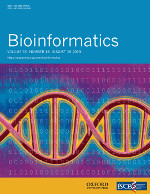 |
Temporal network alignment via GoT-WAVEDavid Aparício, Pedro Ribeiro, Tijana Milenković and Fernando Silva2019 |
Abstract
Motivation: Network alignment (NA) finds conserved regions between two networks. NA methods optimize node conservation (NC) and edge conservation. Dynamic graphlet degree vectors are a state-of-the-art dynamic NC measure, used within the fastest and most accurate NA method for temporal networks: DynaWAVE. Here, we use graphlet-orbit transitions (GoTs), a different graphlet-based measure of temporal node similarity, as a new dynamic NC measure within DynaWAVE, resulting in GoT-WAVE. Results: On synthetic networks, GoT-WAVE improves DynaWAVE’s accuracy by 30% and speed by 64%. On real networks, when optimizing only dynamic NC, the methods are complementary. Furthermore, only GoT-WAVE supports directed edges. Hence, GoT-WAVE is a promising new temporal NA algorithm, which efficiently optimizes dynamic NC. We provide a user-friendly user interface and source code for GoT-WAVE.
Keywords
Network Alignment; Graphlets; Temporal Networks
Digital Object Identifier (DOI)
doi 10.1093/bioinformatics/btz119
Publication in PDF format
Software
Journal/Conference/Book
BioinformaticsReference (text)
David Aparício, Pedro Ribeiro, Tijana Milenković and Fernando Silva. Temporal network alignment via GoT-WAVE. In Bioinformatics, Vol. 35(18), pp. 3527-3529, Oxford University Press, September, 2019.
Bibtex
@article{ribeiro-BIOINFORMATICS2019,
author = {David Aparício and Pedro Ribeiro and Tijana Milenković and Fernando Silva},
title = {Temporal network alignment via GoT-WAVE},
doi = {10.1093/bioinformatics/btz119},
journal = {Bioinformatics},
volume = {35},
issue = {18},
pages = {3527-3529},
publisher = {Oxford University Press},
month = {September},
year = {2019}
}